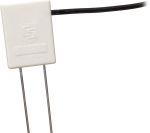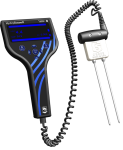
Diseñada para monitorización a largo plazo






Resumen
La CS616 mide el contenido volumétrico de agua desde el 0% hasta saturación. La sonda tiene una salida de señal en frecuencia de megahertz, fácilmente leible por nuestros dataloggers Campbell Scientific.
Leer másVentajas y características
- Compatible con la mayoría de dataloggers Campbell Scientific
- Alta precisión
- Tiempo de respuesta rápida
- Diseñado para monitorización desatendida a largo plazo del contenido de agua
- Compatible con multiplexores AM16/32, permitiendo medir múltiples sensores
- Las varillas de la sonda se pueden insertar desde la superficie o enterrarlo en cualquier orientación.
Imágenes

Descripción detallada
The CS616 is comprised of two 30-cm-long stainless steel rods connected to the measurement electronics. The circuit board is encapsulated in epoxy, and a shielded four-conductor cable is connected to the circuit board to supply power, enable probe, and monitor the output.
The CS616 measures the volumetric water content of porous media (such as soil) using the time-domain measurement method; a reflectometer (cable tester) such as the TDR100 is not required. This method consists of the CS616 generating an electromagnetic pulse. The elapsed travel time and pulse reflection are then measured and used to calculate soil volumetric water content.
Response Characteristics
The signal propagating along the parallel rods of the CS616 is attenuated by free ions in the soil solution and conductive constituents of the soil mineral fraction. In most applications, the attenuation is not enough to affect the CS616 response to changing water content, and the response is well described by the standard calibration. However, in soil with relatively high soil electrical conductivity levels, compacted soils, or soils with high clay content, the calibration should be adjusted for the specific medium. Guidance for making these adjustments is provided in the operating manual.
Preguntas frecuentes
Número de FAQs relacionadas con CS616: 37
Expandir todoDesplegar todo
-
If the CS615 rod length is reduced, the response of the probe to water content will change, and the recommended calibration is no longer valid. Additionally, reducing rod length will adversely affect the water content measurement resolution. However, the CS615 will respond in a similar manner to the response with standard length rods (30 cm). The response needs to be described for the modified probe to generate a calibration. CS615 water content resolution is better than 0.2% volumetric water content with 30 cm rods. If the rods are cut by 15 cm, water content resolution will be between 1% and 2%. A few additional points are:
- Probes with rods less than 15 cm may be unstable.
- A calibration of CS615 output to volumetric water content will have to be established using field or laboratory measurements. Field calibration measurements can be made by recording the CS615 period with the probe in soil, removing the probe and taking samples of known volume for use with gravimetric water contents.
- Water content measurement resolution will be affected.
- Cutting the rods will void their warranty.
-
The CS616 has a faster period output than the CS615-L, so it does not work with the 21X dataloggers.
-
If the electrical conductivity within the waste is less than 5 dS/m and there is good contact between the probe rods and the waste, the CS616/CS625 should respond predictably to changes in water content. The heterogeneous nature and changing bulk density of solid waste, however, make calibration difficult.
-
If a soil-specific calibration is performed, the CS616/CS625 may be used in soil with a maximum bulk electrical conductivity of 5 dS/m.
-
No. Although the CS616/CS625 could be calibrated to convert its period reading to the dielectric permittivity of snow, there is not an easy way to relate the permittivity to liquid water content. This is because the density of snow changes over time and the amount of liquid water that can be held in the solid matrix is relatively small. Additionally, the sensor emits infrared radiation that melts snow away from its rods, similar to the way snow melts around the base of a tree.
The CS616 and CS625 are not appropriate sensors for this application because of the lack of good contact between the rods and the snow, as well as the dynamic nature of the solid matrix.
-
The cable for the sensors is rugged and resistant to damage from the sun and typical weather conditions. However, it is susceptible to damage from rodents, machinery, shovels, and so forth. Running the cable through electrical conduit or PVC pipe will help protect it, but this is not an absolute requirement. In areas where rodent activity is low, direct burial in a trench is usually sufficient. A particularly vulnerable location is where the buried cables exit the ground and enter the enclosure housing the data logger. At that exit point, take steps to protect the cable from damage.
-
The CS616/CS625 will survive frozen soil conditions, but the principle behind using bulk soil dielectric permittivity to estimate water content requires that the water be in liquid form. When soil water freezes, its dielectric drops from approximately 80 to 4, making it indistinguishable from soil solids. Consequently, the CS616/CS625 is not able to measure the water content of frozen soil.
-
Yes. The rugged design of the CS616/CS625 protects the probe electronics from water under these conditions. Many CS616/CS625 reflectometers have been working reliably in very wet conditions for more than ten years.
-
Fine roots do not significantly affect the CS616/CS625 reading.
-
Yes. For program examples and guidance on using a multiplexer with one of these reflectometers, see the CS616 and CS625 instruction manual.
Compatibilidad
Nota: lo siguiente muestra información de compatibilidad notable. No es una lista de todos los productos compatibles.
Dataloggers
| Producto | Compatible | Nota |
|---|---|---|
| CR1000 (retired) | ||
| CR1000X (retired) | ||
| CR1000Xe | ||
| CR300 (retired) | ||
| CR3000 (retired) | ||
| CR310 | ||
| CR350 | ||
| CR6 | ||
| CR800 (retired) | ||
| CR850 (retired) |
Información de compatibilidad adicional
RF Considerations
The RF emissions are below FCC and EU limits as specified in EN61326 if the CS616 is enabled less than 0.6 ms, and measurements are made less frequently than once a second. External RF sources can also affect the CS616 operation. Consequently, the CS616 should be located away from significant sources of RF such as ac power lines and motors.
Installation Tool
The CS650G makes inserting soil-water sensors easier in dense or rocky soils. This tool can be hammered into the soil with force that might damage the sensor if the CS650G was not used. It makes pilot holes into which the rods of the sensors can then be inserted. It replaces both the 14383 and 14384.
Data Logger Considerations
The reflectometer connects directly to one of the data logger’s single-ended analog inputs. A data logger control port is typically used to enable the CS616 for the amount of time required to make the measurement. Data logger instructions convert the probe square-wave output to period which is converted to volumetric water content using a calibration.
Especificaciones
| Measurements Made | Volumetric water content (VWC) of porous media (such as soil) |
| Measurement Range | 0% to saturation |
| Water Content Accuracy | ±2.5% VWC (using standard calibration with bulk EC of ≤ 0.5 dS m-1, bulk density of ≤ 1.55 g cm-3, and measurement range of 0% to 50% VWC) |
| Required Equipment | Measurement system |
| Soil Suitability | Long rods and lower frequency are well-suited for soft soil with low electrical conductivity (< 2 dS/m). |
| Rods | Not replaceable |
| Sensors | Not interchangeable |
| Operating Temperature Range | 0° to +70°C |
| Probe-to-Probe Variability | ±0.5% VWC in dry soil, ±1.5% VWC in typical saturated soil |
| Precision | Better than 0.1% VWC |
| Resolution | 0.1% VWC |
| Output | ±0.7 V square wave (with frequency dependent on water content) |
| Current Drain |
|
| Power Supply Voltage | 5 Vdc minimum; 18 Vdc maximum |
| Enable Voltage | 4 Vdc minimum; 18 Vdc maximum |
| Electromagnetic | CE compliant (Meets EN61326 requirements for protection against electrostatic discharge.) |
| Rod Spacing | 32 mm (1.3 in.) |
| Rod Diameter | 3.2 mm (0.13 in.) |
| Rod Length | 300 mm (11.8 in.) |
| Probe Head Dimensions | 85 x 63 x 18 mm (3.3 x 2.5 x 0.7 in.) |
| Cable Weight | 35 g per m (0.38 oz per ft) |
| Weight | 280 g (9.9 oz) without cable |
Documentos
Folletos producto
Documentos técnicos
Conformidad
Casos de aplicación
Tropical volcanic islands are biodiversity hotspots where the Critical Zone (CZ) remains poorly studied. In......leer más
Korea Expressway Corporation (KEC) was established in 1969 to construct and manage expressways throughout South......leer más
The Delaware Environmental Observing System (DEOS) is a real-time system dedicated to monitoring environmental conditions......leer más
The West Texas Mesonet (WTM) project was initiated by Texas Tech University in 1999 to......leer más










